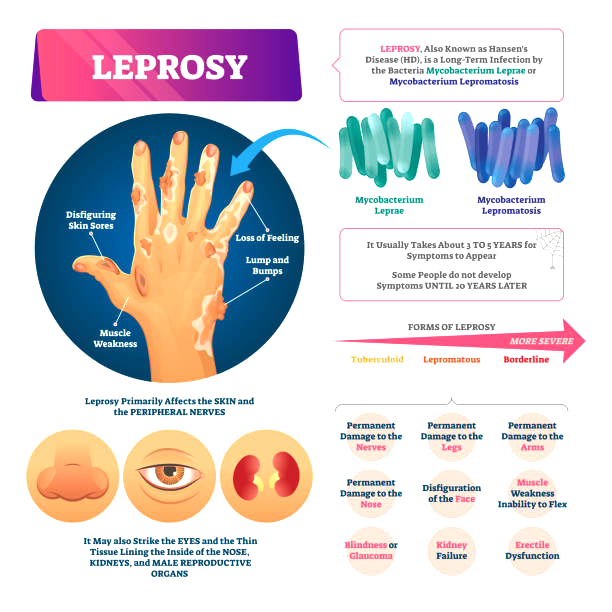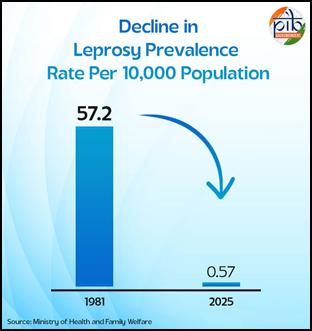Facts for UPSC Mains
India's Fight Against Leprosy
- 21 Oct 2025
- 6 min read
Why in News?
India’s leprosy prevalence rate has declined from 57.2 per 10,000 in 1981 to 0.57 in 2025, marking a 99% reduction.
- The National Leprosy Eradication Programme (NLEP) has now adopted the National Strategic Plan and Roadmap for Leprosy (2023-2027), aiming to interrupt transmission and achieve zero indigenous cases by 2030.
Leprosy
- Leprosy (Hansen’s disease) is a chronic infectious disease caused by Mycobacterium leprae. It affects the skin, nerves, eyes, and respiratory tract, leading to ulcers, deformities, and disability if untreated.
- It spreads through droplets from the nose and mouth during close contact with untreated individuals.
- Leprosy is a neglected tropical disease (NTD) which still occurs in more than 120 countries, with around 200 000 new cases reported every year.
How Has India Battled Leprosy Since Independence?
- Early Efforts:
- 1954-55: Launch of the National Leprosy Control Programme (NLCP) using Dapsone monotherapy (antibiotic medication).
- 1983: NLCP transitioned to the National Leprosy Eradication Programme (NLEP, a Centrally Sponsored Scheme) after WHO endorsed Multi Drug Therapy (MDT) in 1982.
- The introduction of MDT in India in 1983 revolutionized leprosy treatment, with therapy provided free of cost to patients through WHO support.
- Key Outcomes Under NLEP:
- Elimination Achieved: India attained national leprosy elimination status (prevalence rate <1/10,000) in 2005 and sustained it.
- As of 2025, PR is 0.57 nationally, and Grade 2 disability has declined to 1.88 per million.
- Reduced Transmission and Disability: Child cases among new detections fell from 9.04% (2014-15) to 4.68% (2024-25).
- New case detection rate dropped from 9.73 to 7.0 per 100,000 in the same period.
- Post Exposure Prophylaxis (PEP) coverage among eligible contacts improved to 92%.
- Elimination Achieved: India attained national leprosy elimination status (prevalence rate <1/10,000) in 2005 and sustained it.
- National Strategic Plan (NSP) 2023-2027: The NLEP is developing a new strategy aligned with the Global Leprosy Strategy 2021-2030 and the WHO Neglected Tropical Diseases Roadmap, aiming to end leprosy transmission by 2030 and recover from the Covid-19 impact.
- It outlines the strategic interventions and lays out a clear-cut roadmap to achieve the goal of interruption in transmission of leprosy by 2027.
Other National and Global Initiatives to Eliminate Leprosy
At National Level
- Nikusth 2.0 Portal: Digitized system for patient tracking and district monitoring.
- National AMR Surveillance for Leprosy (2023): Tracks drug resistance trends.
- Integration with Ayushman Bharat, Rashtriya Bal Swasthya Karyakram (RBSK) and Rashtriya Kishore Swasthya Karyakram (RKSK): Ensures screening for all age groups.
- PVTG Tagging: Inclusion of Particularly Vulnerable Tribal Groups under PM-JANMAN.
- Special Monitoring: For 121 districts with higher prevalence (>1/10,000).
Global Collaboration
- WHO: India-WHO collaboration ensures free MDT supply, technical support, and programme monitoring. WHO also supported India’s Modified Leprosy Elimination Campaigns (MLECs), Special Action Projects for remote areas, and the COMBI (Communication for Behavioural Impact) pilot in Bihar.
- World Bank: Funded Information, Education, and Communication (IEC) and community-based interventions (1993-2004).
|
Drishti Mains Question: The National Leprosy Eradication Programme (NLEP) is a testament to India's success in public health management. Discuss the evolution and key strategies of the NLEP that led to the elimination of leprosy as a public health problem. |
Frequently Asked Questions (FAQs)
1. What is leprosy?
Leprosy (Hansen’s disease) is a chronic infectious disease caused by Mycobacterium leprae. It affects the skin, nerves, eyes, and respiratory tract, leading to ulcers, deformities, and disability if untreated.
2. What is the current leprosy prevalence rate in India (2025)?
India’s national prevalence rate is 0.57 per 10,000 (2025); 31 states and 638 districts sustain PR <1/10,000, confirming national elimination status.
3. What is Nikusth 2.0 and its significance?
Nikusth 2.0 is a digitized ICT portal (launched 2023) for real-time patient records, drug stock management and monitoring—strengthening surveillance and program responsiveness.
4. How does the NSP 2023-27 aim to end transmission?
NSP 2023-27 focuses on accelerated case detection, intensified surveillance, chemoprophylaxis, digital tools, AMR surveillance, vaccine development and integration with primary care to interrupt transmission by 2030.
UPSC Civil Services Examination Previous Year Question (PYQ)
Mains
Q. Appropriate local community-level healthcare intervention is a prerequisite to achieving ‘Health for All’ in India. Explain. (2018)





.png)



